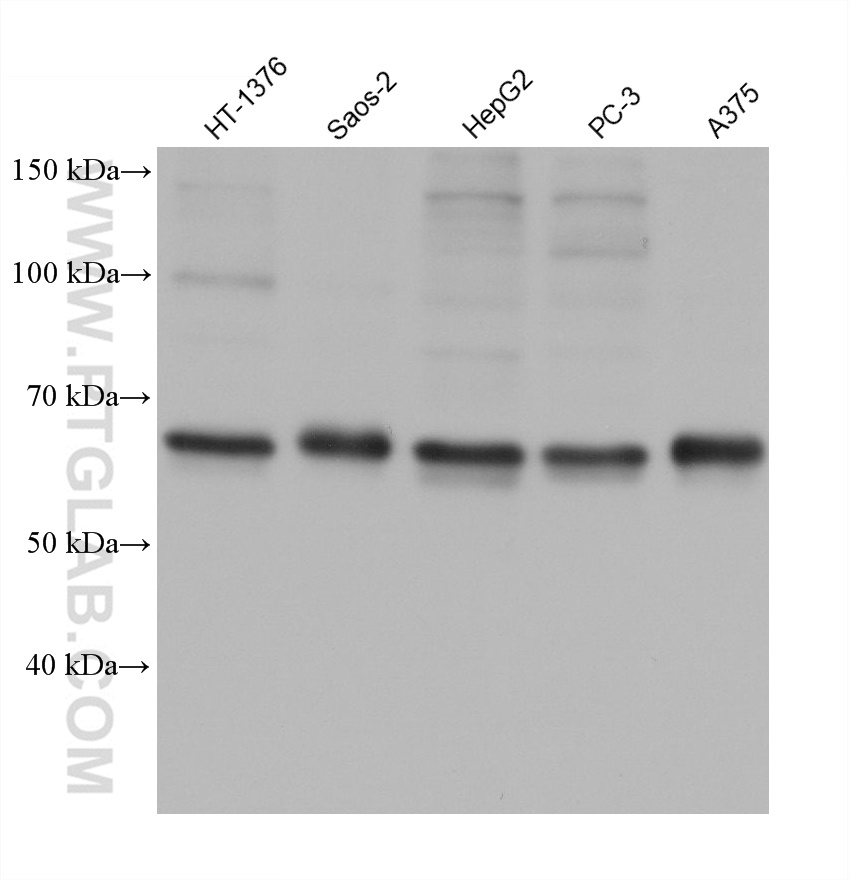验证数据展示
经过测试的应用
| Positive WB detected in | HT-1376 cells, Saos-2 cells, HepG2 cells, PC-3 cells, A375 cells |
推荐稀释比
| 应用 | 推荐稀释比 |
|---|---|
| Western Blot (WB) | WB : 1:5000-1:50000 |
| It is recommended that this reagent should be titrated in each testing system to obtain optimal results. | |
| Sample-dependent, Check data in validation data gallery. | |
产品信息
68559-1-Ig targets GBP2 in WB, ELISA applications and shows reactivity with human samples.
| 经测试应用 | WB, ELISA Application Description |
| 经测试反应性 | human |
| 免疫原 |
CatNo: Ag24108 Product name: Recombinant human GBP2 protein Source: e coli.-derived, PET28a Tag: 6*His Domain: 131-481 aa of BC022272 Sequence: MGTINQQAMDQLHYVTELTDRIKANSSPGNNSVDDSADFVSFFPAFVWTLRDFTLELEVDGEPITADDYLELSLKLRKGTDKKSKSFNDPRLCIRKFFPKRKCFVFDWPAPKKYLAHLEQLKEEELNPDFIEQVAEFCSYILSHSNVKTLSGGIPVNGPRLESLVLTYVNAISSGDLPCMENAVLALAQIENSAAVEKAIAHYEQQMGQKVQLPTETLQELLDLHRDSEREAIEVFMKNSFKDVDQMFQRKLGAQLEARRDDFCKQNSKASSDCCMALLQDIFGPLEEDVKQGTFSKPGGYRLFTQKLQELKNKYYQVPRKGIQAKEVLKKYLESKEDVADALLQTDQSLS 种属同源性预测 |
| 宿主/亚型 | Mouse / IgG1 |
| 抗体类别 | Monoclonal |
| 产品类型 | Antibody |
| 全称 | guanylate binding protein 2, interferon-inducible |
| 别名 | 2D7G4, EC:3.6.5.-, GBP 2, GBP-2, GTP-binding protein 2 |
| 计算分子量 | 591 aa, 67 kDa |
| 观测分子量 | 67 kDa |
| GenBank蛋白编号 | BC022272 |
| 基因名称 | GBP2 |
| Gene ID (NCBI) | 2634 |
| RRID | AB_3085261 |
| 偶联类型 | Unconjugated |
| 形式 | Liquid |
| 纯化方式 | Protein G purification |
| UNIPROT ID | P32456 |
| 储存缓冲液 | PBS with 0.02% sodium azide and 50% glycerol, pH 7.3. |
| 储存条件 | Store at -20°C. Stable for one year after shipment. Aliquoting is unnecessary for -20oC storage. |
背景介绍
GBP2 is a member of the GTPase family and is crucial to host immunity against pathogens. GBP2 is also used as a marker of interferon (IFN) responsiveness, because it is one of the most highly expressed genes after IFN-γ stimulation. Increased GBP2 expression is also associated with a better prognosis in breast cancer and may have a role in T-cell defense against breast cancer. Interestingly, GBP2 expression in NIH/3T3 fibroblasts inhibited Rac activation and matrix metalloproteinase-9 expression, suggesting a possible role for GBP2 in regulating cancer metastasis. The molecular weight of GBP2 is 67 kDa. (PMID: 29072687, 35383115)
实验方案
| Product Specific Protocols | |
|---|---|
| WB protocol for GBP2 antibody 68559-1-Ig | Download protocol |
| Standard Protocols | |
|---|---|
| Click here to view our Standard Protocols |


